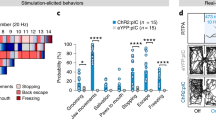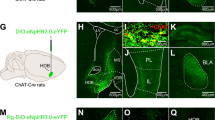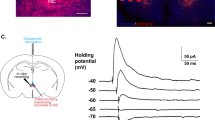Abstract
The gene for the Light Chain fragment of Tetanus Toxin (LC) induces synaptic inhibition by preventing the release of synaptic vesicles. The present experiment applied this approach within the rat midbrain in order to demonstrate that LC gene expression can achieve functionally and anatomically discrete effects within a sensitive brain structure. The deep layers of the superior colliculus/deep mesencephalic nucleus (dSC/DpMe) that are located in the rostral midbrain has been implicated in fear-induced increase of the acoustic startle reflex (fear potentiated startle) but exists in close proximity to neural structures important for a variety of critical functions. The dSC/DpMe of adult rats was injected bilaterally with adenoviral vectors for LC, green fluorescent protein, or vehicle. Synaptobrevin was depleted in brain regions of adenoviral LC expression. LC gene expression in the dSC/DpMe inhibited the increase in startle amplitude seen with the control viral infection, and blocked context-dependent potentiation of startle induced by fear conditioning. Although LC gene expression reduced the absolute amount of cue-specific fear potentiated startle, it did not decrease percent potentiated startle to a cue, nor did it reduce fear-induced contextual freezing, nonspecific locomotor activity, or general health, indicating that its effects were functionally and anatomically specific. Thus, vector-driven LC expression inhibits the function of deep brain nuclei without altering the function of surrounding structures supporting its application to therapeutic neuromodulation.
This is a preview of subscription content, access via your institution
Access options
Subscribe to this journal
Receive 12 print issues and online access
$259.00 per year
only $21.58 per issue
Buy this article
- Purchase on Springer Link
- Instant access to full article PDF
Prices may be subject to local taxes which are calculated during checkout







Similar content being viewed by others
References
Gildenberg P . The history of stereotactic and functional neurosurgery. In: Gildenberg P, Tasker R (eds). Textbook of Stereotactic and Functional Neurosurgery. McGraw-Hill: New York, 1998, pp 5–20.
Mogilner A, Rezai A . Brain stimulation: history, current clinical application, and future prospects. Acta Neurochir 2003; 87: 115–120.
Noordmans A, Song D, Noordsmans C, Garrity-Moses M, During M, Fitzsimmons H et al. Adeno-associated viral glutamate decarboxylase expression in the lateral nucleus of the rat hypothalamus reduces feeding behavior. Gene Therapy 2004; 11: 797–804.
Luo J, Kaplitt M, Fitzsimmons H, Zuzga D, Liu Y, Oshinsky M et al. Subthalamic GAD gene therapy in a Parkinson's disease rat model. Science 2002; 298: 425–429.
During M, Kaplitt M, Stern M, Eidelberg D . Subthalamic GAD gene transfer in Parkinson disease patients who are candidates for deep brain stimulation. Hum Gene Ther 2001; 12: 1589–1591.
Teng Q, Tanase D, Liu J, Garrity-Moses M, Baker K, Boulis N . Adenoviral clostridial light chain gene-based synaptic inhibition through synaptobrevin elimination. Gene Therapy 2005; 12: 108–119.
Meloni E, Davis M . GABA in the deep layers of the superior colliculus/mesencephalic reticular formation mediates the enhancement of startle by the dopamine D1 receptor agonist SKF 82958 in rats. J Neurosci 2000; 20: 5374–5381.
Meloni E, Davis M . Muscimol in the deep layers of the superior colliculus/mesencephalic reticular formation blocks expression but not acquisition of fear-potentiated startle in rats. Behav Neurosci 1999; 113: 1152–1160.
Zhou Z, Davis M . Fear-potentiated startle in rats is mediated by neurons in the deep layers of the superior colliculus/deep mesencephalic nucleus of the rostral midbrain through the glutamate non-NMDA receptors. J Neurosci 2004; 24: 10326–10334.
Thomas C, Schiedner G, Kochanek S, Castro M, Lowenstein P . Peripheral infection with adenovirus causes unexpected long-term brain inflammation in animals injected intracranially with first-generation, but not with high-capacity, adenovirus vectors: toward realistic long-term neurological gene therapy for chronic diseases. Proc Natl Acad Sci USA 2000; 97: 7482–7487.
Boulis N, Bhatia V, Brindle T, Holman H, Krauss D, Blaivis M et al. Adenoviral nerve growth factor and β-galactosidase transfer to spinal cord: a behavioral and histological analysis. J Neurosurg 1999; 90: 99–108.
Niemann H . Molecular biology of clostridial neurotoxins. In: Alouf JE, Freer JH (eds). Sourcebook of Bacterial Protein Toxins. Academic Press: London, 1991, pp 303–348.
Rossetto O, Seveso M, Caccin P, Schiavo G, Montecucco C . Tetanus and botulinum neurotoxins: turning bad guys into good by research. Toxicon 2001; 39: 27–41.
Humeau Y, Doussau F, Grant N, Poulain B . How botulinum and tetanus neurotoxins block neurotransmitter release. Biochimie 2000; 82: 427–446.
Schiavo G, Benfenati F, Poulain B, Rossetto O, Polverino de Laureto P, DasGupta B et al. Tetanus and botulinum-B neurotoxins block neurotransmitter release by proteolytic cleavage of synaptobrevin. Nature 1992; 359: 832–835.
Brooks V, Curtis D, Eccles J . Mode of action of tetanus toxin. Nature 1955; 175: 120–121.
Benecke R, Takano K, Schmidt J, Henatsch H . Tetanus toxin induced actions on spinal Renshaw cells in Ia-inhibitory interneurones during development of local tetanus in the cat. Exp Brain Res 1977; 27: 271–286.
Aoki K, Barker C, Danthinne X, Imperiale M, Nabel G . Efficient generation of recombinant adenoviral vectors by Cre-lox recombination in vitro. Mol Med 1999; 5: 224–231.
Acknowledgements
We thank Thomas Binz, PhD of the Medizinische Hochschule, Hannover, Germany for providing anti-LC antibodies and Sean Sweeney, PhD of the York University, the United Kingdom, for providing plasmid DNA. We also thank Dr Michael imperiale of the University of Michigan for providing the adenovirus vector. This work was supported by the National Institutes of Health KO8 grant NS43305, the Amyotrophic Lateral Sclerosis Association, and the Christopher Reeves Paralysis Foundation (NB) and National Institute of Mental Health grants MH 47840, MH 58922, MH 52384, MH 59906, the Woodruff Foundation, and the Science and Technology Center (The Center for Behavioral Neuroscience of the National Science Foundation under Agreement No. IBN-9876754) and the Yerkes Base Grant.
Author information
Authors and Affiliations
Corresponding author
Rights and permissions
About this article
Cite this article
Zhao, Z., Krishnaney, A., Teng, Q. et al. Anatomically discrete functional effects of adenoviral clostridial light chain gene-based synaptic inhibition in the midbrain. Gene Ther 13, 942–952 (2006). https://doi.org/10.1038/sj.gt.3302733
Received:
Revised:
Accepted:
Published:
Issue Date:
DOI: https://doi.org/10.1038/sj.gt.3302733
Keywords
This article is cited by
-
Viral Clostridial Light Chain Gene-based Control of Penicillin-induced Neocortical Seizures
Molecular Therapy (2007)
-
Reversible Unilateral Nigrostriatal Pathway Inhibition Induced Through Expression of Adenovirus-mediated Clostridial Light Chain Gene in the Substantia Nigra
NeuroMolecular Medicine (2007)



